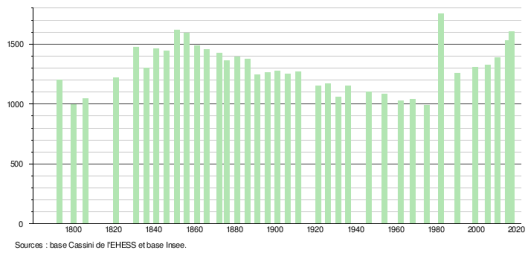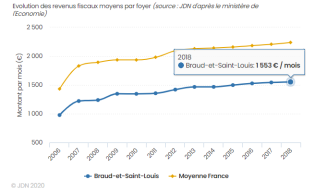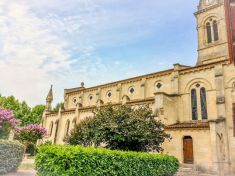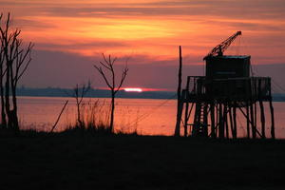Braud-et-Saint-Louis, Gironde, Nouvelle-Aquitaine 作者: 来源: 发布时间:2021-06-09
I.Population and Area
Total Area: 49, 24 km2 (19.00 sq mi)
Population in 2017: 1605
Population Density: 33 /km2 (84 /sq mi)

Histogram of demographic change
II.Natural Geography (environment and resources)

lBraud-et-Saint-Louis is a commune in southwestern France, in the Gironde department in the Nouvelle-Aquitaine region.
lThe town is located in the Blayais, on the edge of the Gironde estuary.
lOn the territory of the commune is installed the nuclear power plant of Blayais.
lThe town is at the confluence of Livenne with the Gironde estuary.
III.ECONOMY
Employment income (%): 71.4 (2017)
Average employment income (€):1 553 net per month (18 636 net per year)(2018)

Evolution of average monthly net wages
Sources : http://www.journaldunet.com/business/salaire/braud-et-saint-louis/ville-33073
https://insee.fr/fr/statistiques/2011101?geo=COM-33073#tableau-CEN_G2
IV.Industrial Characterisitics
lSectors of activity most represented in Braud-et-Saint-Louis
The table below lists the five sectors of activity with the most companies in Braud-et-Saint-Louis during the period from to as well as the share of each sector on the total number of companies in the common.
Sector of activity | Number of companies | Share of companies |
Permanent crops | 29 | 13.6% |
Rental and operation of own or leased real estate | 27 | 12.6% |
Sport-related activities | 14 | 6.5% |
Animal production | 12 | 5.6% |
Activities of other membership organizations | 12 | 5.6% |
The companies that generate the most turnover in Braud-et-Saint-Louis
The list displayed below presents the companies established in Braud-et-Saint-Louis and which report the highest 2018 turnover in the municipality.
1)SARL PHILBER(specializes in the local road freight transport business sector)
2)MARTIN(specialized in the sector of crop support activities)
SARL PHILBER, a limited liability company, has been in business for 15 years.
Located in BRAUD-ET-SAINT-LOUIS (33820), it specializes in the local road freight transport business sector. Its workforce is between 10 and 19 employees.
In 2019, it achieved a turnover of € 1,519,700.00.
The balance sheet total increased by 33.58% between 2018 and 2019.
MARTIN, a simplified joint stock company, has been active for 16 years.
Based in BRAUD-ET-SAINT-LOUIS (33820), it is specialized in the sector of crop support activities. Its workforce is between 10 and 19 employees.
In 2019 it achieved a turnover of € 348,800.00.
The balance sheet total increased by 9.59% between 2018 and 2019.
Sources: http://entreprises.lefigaro.fr/braud-et-saint-louis/ville-33073
https://www.societe.com/societe/martin-453333171.html
V.Attractions
1.THE CHURCH OF SAINT SATURNIN

Rebuilt in 1898 in a neo-gothic style near the primitive church.
A special feature: its North-South orientation, unlike the usual Facade - West / choir - East orientation.
Portal of Roman inspiration with 3 arches.
Remarkably restored during the years 1988 - 1989.
Bell tower topped with a polygonal spire Height: 37 m.
The figurative stained glass windows of the choir and rose window have been preserved.
The stained-glass windows on the aisles were decorated by the master glassmaker, P - E Brouhard, who chose as their theme: life for the drawings and the cycle of the day for the colors. Depending on their arrangement (east, west, north or south), the stained-glass windows take on cold shades for the rising sun, then warmer and warmer to symbolize the warming of the earth during the rise from the sun to the zenith, finally the intensity of the sun decreases to arrive at the dark shades which are those of the evening.
2.The Domaine de la Paillerie

Area: 23 ha
Built in 1727 and rebuilt in 1797.
Formerly a prosperous wine estate, it housed a distillery.
Property of the municipality since 1995, it has been under restoration since 2006.
On the program, repair of the right wing, the sheepfold, the dovecote, the farmer's house. la-paillerie
The task was entrusted to the association of Compagnons Bâtisseurs Aquitaine which leads professional integration projects by learning the various building trades, here with the discovery of ancient techniques, ensuring the rehabilitation of heritage.
3.The Gironde estuary: the estuarine sea

The Gironde estuary corresponds to the mouth of the Garonne and Dordogne rivers subject to the influence of the tides. It thus extends upstream from Bordeaux to La Réole and beyond Libourne to Pessac sur Dordogne and Coutras.
More commonly, the Gironde estuary is restricted from its mouth (Pointe de Grave) Boat on the Bec d'Ambès estuary which marks the confluence of the two rivers (Dordogne and Garonne).
Under the effect of the tides, twice a day, the water level varies by about 5 meters. The salinity of the water is important especially at the time of strong tides when the ocean waters penetrate abundantly into the estuary. However, the sea flow meets the fluvial thrust that opposes it.
This movement gives it its rhythm and the strength of its currents. Each year, 2 million tonnes of sediment are carried by the Garonne and Dordogne rivers. This moving accumulation gives this cream color so particular to the waters of the estuary.
4.Blaye
Since 2008 the citadel of Blaye and the Verrou Vauban have been inscribed on the world heritage list by UNESCO within the Network of Major Sites of Vauban.
Le Verrou Vauban prevented the enemy from reaching Bordeaux. It is made up of three forts: the citadel of Blaye, Fort Pâté and Fort Médoc.
As for the Network of major sites, it has 11 buildings throughout France, representative of the genius of the 17th century architect, Sébastien Vauban.
To discover the citadel of Blaye and the Verrou Vauban, we offer guided tours of the citadel and its underground passages from April to September, cruises on the Girode estuary and themed guided tours all year round.
At the bend of an alleyway in the citadel of Blaye, on the corniche road from Bourg, in Land of Birds or on one of our hiking trails, everything is conducive to a beautiful encounter.
5.Haute Gironde country
Country where the waters of the Dordogne, the Garonne and the Atlantic merge to give birth to the largest estuary in Western Europe, the Haute Gironde has something to satisfy all appetites for nature and culture, leisure and sports, discovery of the vineyard and the local gastronomy.
Marshes, vineyards, forests, lakes and rivers but also small ports, charming towns and villages, citadels, wine-growing castles, Romanesque churches make up pleasant landscapes to discover in all seasons.
vineyards and landscape of Gironde Whether for a Weekend or a longer stay, the Haute Gironde offers many options for stays and accommodation in the heart of the vineyard: hotels, furnished tourist accommodation, guest rooms, residences hotels, campsites ... Here, roads and hiking trails also open the way to other landscapes: the Royannais region, Saintonge, Médoc, the riches of Bordeaux or the medieval city of Saint-Emilion.
The Pays de la Haute Gironde brings together the Communities of communes of Blaye, Grand Cubzaguais, Estuaire and Latitude Nord Gironde. It has 63 municipalities and nearly 90,000 inhabitants.
The Country brings together public and private actors from Haute Gironde around a common territorial project that it leads.
He initiates, implements and coordinates certain actions for which he has the initiative; it supports other promoters when their projects contribute to the achievement of the objectives defined in the Haute Gironde 2015-2020 development strategy.
It mobilizes numerous financial and operational mechanisms for the benefit of the territory, its inhabitants, its businesses, its communities (municipalities and communities of municipalities) and its private actors.
It relies on a Development Council to coordinate the actors and the population.
Sources : http://www.mairie-braud.fr/decouvrir-braud/historique
http://www.mairie-braud.fr/decouvrir-braud/la-paillerie
http://www.mairie-braud.fr/decouvrir-braud/tourisme
http://www.pays-hautegironde.fr/
https://www.bbte.fr/exp%C3%A9riences/pique-nique-avec-vue/
VI.History
(Sources: "Essay on the history of archeology in the canton" C. BASTISSE and D. PICOTIN The Vitrezais "Saint Simon à Blaye" notebooks and the one devoted to Braud and Saint Louis. These books can be consulted at the municipal library )
Sanctus Saturninus de Brau is the name found in the 14th century. Braud would be an abbreviation of Beraud, Saintonge form of the Germanic name Beroald, which means Old Lord. Based on the form "Embrand" which formerly would have designated this locality.
Several possible Braud ethymologies
The name of Braud could also come from the Gascon Braou which means Bull, a sign that this form of cattle was raised in swamps.
Municipality formed from the reunion of two former parishes: Braud, from the old French "Brai", mud, marshy place and St Louis, parish founded by the Duke of St Simon in 1656 and included in the town of Braud in 1802.
Origin of the name of the commune of Braud and Saint Louis
Braud would come from beraud, Saintongeaise form of the Germanic name berard, old lord "or from the Gascon braou," bull "sign that these cattle were raised in the swamps or even from the old French pitch," mud "," marshy place ".
The parish of Braud is mentioned under the name of Sanctus Saturninus (Saint Saturnin) de Braud.
The drying up of the marshes in the 17th century, at the initiative of Duke Claude de Saint Simon, governor of Blaye, was to transform the marshes into "good nature of arable land" and create villages. The drying up, the plots are allocated, the smallholdings appear. The number of inhabitants encouraged the Duke of Saint Simon to found two parishes: the parish of Saint Louis (all the part of the large marsh located between the Gironde and the ring canal, between the Canal des Callonges and that of Fréneau), in the honor of the King of France and that of Saint Simon.
The church, the presbytery and the cemetery built between 1665 and 1667 were destroyed during the Revolution of 1789.
After the Revolution, the parish of Saint Saturnin de Braud and the parish of Saint Louis des Marais united to form the commune of Braud and Saint Louis.
Sources: http://www.mairie-braud.fr/decouvrir-braud/historique
VII.Other information
Ornithological park at New Possessions: www.terresdoiseaux.fr
Near Bordeaux, on the Gironde estuary, at the foot of the Port des Callonges, Terres d'Oiseaux invites you to share a special moment on one of the most important migration routes in France.
This exceptional stopover gives you the opportunity to observe many wild, migratory and sedentary birds.
Whether they are large waders, passerines or nesting birds, they find refuge, rest and food in this natural space of 116 ha.
On site, you will appreciate the discovery trails, platforms and observatories specially designed for you, but you will also discover, during your visit, original creations of the Land Art type.
At Terres d'Oiseaux, the installations and scenography have been designed to offer you a world apart, to see, discover and feel. A unique experience where nature is shared.Located on the edge of the Gironde, on an important migration route, this 120 hectare area, redeveloped to rediscover the richness and diversity of estuarine marshes, is an exceptional place of welcome and protection for waterbirds, both migratory and nesters.
On the site, more than 110 species of birds observed.
Every of them has their own home:
A reed bed of more than 40 ha is home to rare birds (blue throat, red fox, star bittern, ...) but also insects, amphibians and mammals such as the otter which is now protected.
Common snipes, white stilts, small plots, crested lapwings, ducks frequent lakes and islets.
Egrets, herons, storks feed on shallow water bodies and wet meadows.
Diurnal raptors such as the Circaetus hunt on meadows and reed beds or on bodies of water (osprey) Some, such as the common kestrel, long-eared owl, common buzzard or black kite, nest in the wooded area.
Controlled management:
Management of a complex hydraulic network made up of a central canal linked directly to the Gironde, ditches and bodies of water. Adapted hydraulic structures to manage water levels, inlets and outlets.
Eco-pastoral management with the presence of Barthai ponies and Bordeaux cows, endangered rustic animals, entrusted by the Conservatory of Breeds of Aquitaine. Landes sheep also help maintain the site.
For visitors and nature lovers:
1)Free access to a 10 m high observation tower offering a panoramic view of the estuary, the port, the marshes, the reserve. In this free area, an educational pond for learning about the environment and a natural water treatment station with filters planted with reeds.
2)Paid access by taking your entrance ticket to the reception building.
For the pleasure of discovery, up to 5 km of free walk or guided tour along three marked ornithological trails, dotted with observatories.
Origin of a project:
Enhance a territory by developing ecotourism.
(Partners: Community of Communes of the Estuary, the commune of Braud and Saint Louis and ONCFS).
Stakes:
Make the New Possessions reserve a tourist attraction by transforming it into an ornithological park, by renovating the existing buildings for the reception and catering of visitors (reception / ticket office, restaurant with panoramic terrace overlooking the estuary)
Goals :
1)Preserving a natural heritage by preserving, today essential, a wetland reservoir of biodiversity, managing it and enhancing it.
2)Share with as many people as possible by making the site a place of discovery and walking, while maintaining the tranquility of animals as a priority.
3)Promote the cultural heritage of the region to which the marsh belongs.
4)Contribute to controlled economic development.
History of this nature reserve
1976: construction of the nuclear power plant
The New Possessions are divided into eight "lockers" dyked to receive the sludge extracted from the foundations during the construction of the power plant. A central channel is dug to drain the site.
1991: Bought by an individual who makes it a private commercial hunt, the area is largely drained to promote the development of game (quail, partridge, pheasants, ...). Fallow deer are introduced.
2002: the municipality of Braud and Saint Louis becomes the owner of a very degraded wetland.
2003, with the ONCFS, first arrangements for the reception of avifauna.
From 2003: reception of school groups with discovery of the reserve and educational workshops.
From 2006: open to the public in summer: entertainment program as part of the Estuariennes, carriage rides, cinesite.
Open days: participation in World Wetlands Day in February in particular.
2007: Classification of the site as a hunting and wildlife reserve.
2008-2010: Realization of a management plan to complete the overall development project of this ornithological site dedicated to welcoming the public.
Protarchanara brevilinea, a species of moth considered extinct has been found in the reed beds of Terre d'Oiseaux.
Sources : http://www.mairie-braud.fr/decouvrir-braud/parc-ornithologique
VIII.Contact information
Braud-et-Saint-Louis town hall address :
Braud-et-Saint-Louis town hall
1 place de la Liberation
33820 Braud-et-Saint-Louis
Opening Hours of the town hall:
Saturday: from 9 a.m. to 11 a.m.
Monday to Friday: 8:30 a.m. to 12:00 p.m. and 1:30 p.m. to 5:30 p.m.
Mayor : Jean-Michel Rigal (Mandate : 2014-2020)
Mail: sg@mairie-braud.fr
Phone number: 05 57 42 61 00
Fax: 05 57 42 60 92
Website : http://www.mairie-braud.fr
Sources : http://www.cartesfrance.fr/carte-france-ville/33073_Braud-et-Saint-Louis.html#mairie
